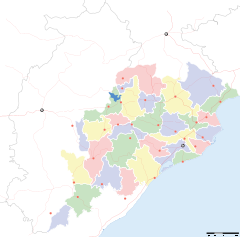- Chintamanisvara Siva Temple
-
Chintamanisvara Siva Temple 
Coordinates: 20°15′00″N 85°50′20″E / 20.25°N 85.83889°ECoordinates: 20°15′00″N 85°50′20″E / 20.25°N 85.83889°E Location Country: India State: Orissa Location: Bhubaneswar Architecture and culture Important festivals: Sivaratri, Siva vivaha, jalasaya, rudrabhisekha Architectural styles: Rekha deul style History Date built:
(Current structure)14th century A.D. Chintamanisvara Siva Temple is a Hindu temple dedicated to Lord Siva locted in Bhubaneswar, the capital of Orissa, India. It is situated at the end of the Chintamanisvara road branching from Cuttack - Puri road near the Old Station Bazar. The temple faces towards west and the enshrined deity is a Siva lingam with a yonipitha.
Contents
The Temple
The temple dates back to 14th century A.D. According to local legend the temple was built by the Kesharis (Somavamsis). Various religious sacraments like Sivaratri, Siva vivaha, jalasaya, rudrabhisekha are performed here. Marriage and thread ceremonies are held here.
Architectural features
On plan, the temple has a square sanctum, the vimana is of rekha order. From bottom to the top the temple has a bada, gandi and mastaka. There are fivefold divisions the panchanga bada and at the base the pabhaga has a set of five mouldings i.e. khura, kumbha, pata, kani and basanta. Khura portion of the temple has partly been buried. Jangha is segmented into tala jangha and upara jangha by a set of three mouldings of the bandhana, baranda with seven mouldings. The gandi is devoid of any decoration and the mastaka as with Orissan temples has components like beki, amalaka, khapuri and kalasa.
Eastern niche enshrines a four armed Kartikeya image. His major left is in varadamudra and right hand holds a mace. His uplifted back left hand holds a cock and his right hand is held over the head of the peacock. Southern niche houses a four armed Ganesa image who is holding rosary in his major right hand and modaka patra in his left hand. His uplifted back right hand holds an ankusa while his left hand holds a broken tooth(tusk).The northern raha niche houses goddess Parvati.
Decorative features
The tala jangha and the upara jangha of the bada are carved with a series of khakhara mundis and pidha mundis respectively. In the beki recess above the kanika paga there is a deula charini where as above the raha paga at the center there are four armed divinities. The base of the doorjamb is carved with two khakhara mundis on either side. Temple is enclosed by a modern compound wall measuring 40.00 square m, 1.80 m in height with a thickness of 0.20 m. There is a four armed Ganesa in the right side of the doorjamb. The deity is holding a Parasu and rosary in his lower left and right arms and modakapatra in upper left and a broken tooth(tusk) in lower left arm.
Chintamanisvara Tank
It is a temple tank located within the precinct of temple. According to local people the tank was dug by the Kesharis. Festivals like Kartika purnima and Sravana purnima are observed here. The tank is rectangular in shape made of laterite measuring 22.40 m in length and 11.20 m in breadth with a depth of 3.00 m. The tank is fed by a natural spring with waters from underground. As a result of which water level is always constant through out the year. There is an outlet in the eastern wall to discharge the excess water.
See Also
- List of temples in Bhubaneswar
Reference notes
- K.C. Panigrahi, Archaeological Remains at Bhubaneswar, Calcutta, 1961. P. 16.
- Lesser Known Monuments of Bhubaneswar by Dr. Sadasiba Pradhan (ISBN 81-7375-164-1)
References
Categories:- Shiva temples
- Hindu temples in Bhubaneswar
Wikimedia Foundation. 2010.


